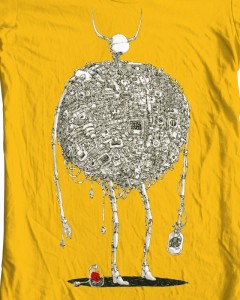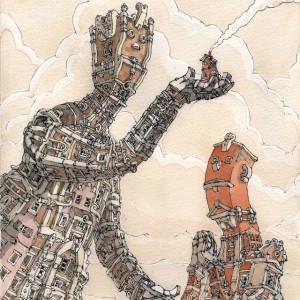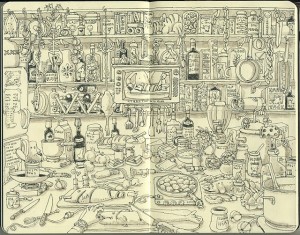There are two types of people I have always envied: morning people, otherwise known as ‘larks’, and heavy sleepers (the latter will be the subject of another post). People who are fortunate enough to possess both qualities are a double blow. As an ‘owl’, who naturally prefers to go to bed late and sleep late, and a pathologically light sleeper, rising early and getting anything done in the morning feels like I’m pushing my way through some kind of invisible retarding gel.
My mother has never understood my morning disorientation and the heavy cloud of grogginess that refuses to shift from my head until lunchtime. My standard childhood response to her cheery burst of “Good morning!” was: “Prove it”. I had hoped that after ten years of working regular office hours the owlish tendencies I’ve had since childhood would have dissipated. But no, despite many years of discipline in forcing myself to bed early, they’ve held on tight.
My eternal quest for a day where getting up before 9am doesn’t feel like a bad hangover or chronic jet lag has led to my interest in ‘chronotypes’. A person’s chronotype refers to their proclivity to be a lark, owl or hummingbird. Larks are most energetic in the morning and prefer to rise early and go to bed early. Their cheery morning chattering and whistling is highly irritating to owls. Owls, on the other hand, are at their optimum in the evening and prefer to sleep and get up late. Hummingbirds are in the middle of the spectrum and account for around 70-80% of people.
There is a distinct cultural bias in favour of larks. I suspect they find sadistic pleasure in organising those 7am workplace breakfast meetings. Larks have no trouble fitting in with society’s norms and standard working hours of starting by 9am, which is probably a vestige from pre-industrial times. In agrarian societies, commencing work in the fields at dawn made the most of the daylight hours and was important for economic production. Hence the prevalence of sayings such as “the early bird catches the worm” and “early to bed and early to rise makes a man healthy, wealthy and wise.”
However, being bright-eyed and bushy tailed in the morning is not just a matter of willpower and getting enough sleep, as many larks would have us believe. Our chronotype is largely determined by genetics. Although a person’s chronotype may change over the course of their lifetime – teenagers and young adults tend to be owls, while children and the elderly are generally larks – it doesn’t usually change relative to one’s peers.
While being an owl or a lark in itself is not a problem, having to maintain a schedule than runs counter to our individual circadian rhythms – that is, our internal 24 hour biological clock – may cause significant health problems. People whose circadian rhythms are out of sync with the schedule they keep are said to have ‘social jet lag’ – a phrase coined by Till Roenneberg of Ludwig Maximilian University in Munich. If larks and owls are forced to adopt normal schedules they encounter all kinds of difficulties with insomnia and sleepiness, and I can personally attest to that.
People with the owlish delayed sleep-phase syndrome (who have difficulty falling asleep before 6am and waking up before 2pm) and those with the larkish advanced sleep-phase syndrome (who fall asleep around 8pm and wake up at 4am) often also suffer from depression or bipolar disorder. According to Colleen McClung of the University of Texas Southwestern Medical Centre, the vast majority of people with major depression have insomnia and can’t sleep, or they sleep too much. This raises the question: are the circadian rhythm disorders causing the depression, or is it the other way around? This is something scientists are still investigating.
Of perhaps greater concern is the effect of shift-work on circadian rhythms which has been linked to increased cancer rates, psychiatric disorders and a range of other metabolic diseases (see the 2009 article in ‘Nature’ magazine) . Researchers at the European Commission’s EUCLOCK are working to understand those links.
Our circadian rhythms are primarily determined by a ‘master clock’ called the supra-chiasmatic nucleus (SCN) in the brain’s hypothalamus. The SCN is synchronized during the day by light signals received by non-rod, non-cone receptors in our eyes. It is thought that there are ‘master genes’ directing the SCN and the physiological processes it regulates.
Interestingly, over the past decade researchers have discovered that the body also has ‘peripheral circadian oscillators’ in organs and tissues outside the SCN. While these peripheral clocks use the SCN as a reference point and usually run in sync, they are also influenced by other time-keeping signals. Researchers suspect that many of the health problems experienced by shift workers arise when the circadian rhythms in different body tissues lose synchrony with each other.
Similarly, the jet lag experienced after a long-haul flight is now thought to be caused by a disruption to the synchrony between the SCN, which resets to local time based on light signals within a day or two, and the peripheral oscillators in other organs which can take over a week to adjust. Thus when we experience jet lag our body is literally out of sync.
Researchers have found that individual differences in chronotype are due not only to the innate differences in circadian period length, but also to differences in how easily a person’s circadian rhythms can be synchronized to the day-night cycle. Evidence suggests that some owls and larks have clocks that are not reset normally each day, and that these people’s peripheral clocks have a tendency to stray from the central one. While hummingbirds find it easy to synchronize their internal clocks with the day-night cycle, owls and larks experience significant difficulties.
So what should we make of all this? For owls like myself, it provides a sense of vindication against larks who claim that we lack willpower, are somehow lazy, and that resetting our internal clock should be an easy task. It also provides empirical justification for the importance of flexible work arrangements so that individuals can work at their optimal performance times. While I am lucky to have a fairly flexible employer in this regard, I hope that society starts paying more attention to the importance of circadian rhythms and that more employers follow suit.



